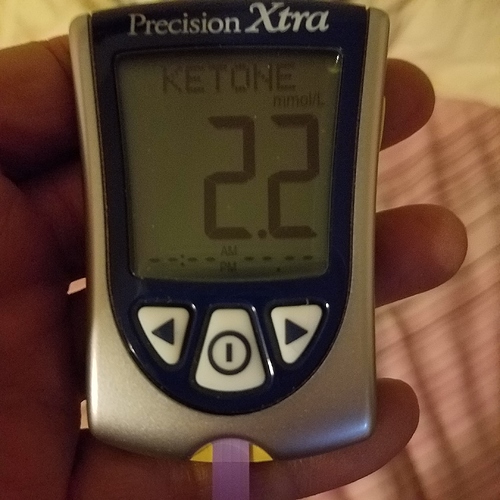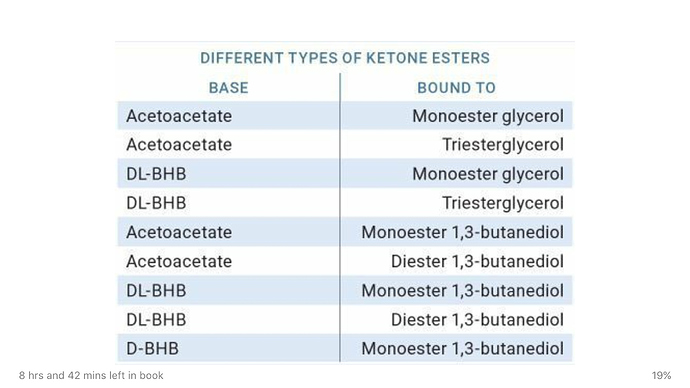My Ketonix correlates well with my blood ketone meter.
My Ketonix is a second generation. I do not have it hooked up to my laptop for data but am going by number of flashes and colors for now.
It flashes 10 blue, 10 green, 10 yellow, and 10 red, red being highest. Yellow is good nutritional ketosis mid range flashes, 5 and up.
If blood ketones are under 1, it flashes low yellows. If blood ketones are high ones or low twos, it flashes high yellows. High twos? One flash red.
Today? At 4.3 blood ketones? 4 flashes red.
Never let’s me down.
Correlates perfectly.
This is great because blood ketone strips are expensive, I try and only use one a day. The Ketonix I can use all day long! Whenever I want to. I often carry it with me.
Ketonix/Blood Ketone correlation
Ketonix readings not agreeing g with blood meter
Urine test strip results in between colors
I have an old Ketonix Sport that i only recently started using again.
I thought that its readings would not be very precise.
But i heard something on “The Ketogenic Athlete” podcast which changed my mind and it goes something like this:
Blood Ketones show your available ketone energy reserves.
Breath Ketones (Acetone) show how many Ketones you have used, the Acetone beeing the waste-product after metabolising ketones.
Therefore depending on circumstances a ketonix might be a even better indicator of the depth of your ketosis.
For example you could be in deep ketosis but because you used up most of your ketones available in the blood during longer exercise your blood ketone readings would be lower and your breath ketone levels higher. This is exactly what i experienced myself and wondered why exercise would kick me almost out of ketosis. There was a different explanation for this that said exercise would mobilize your glycogen reserves and thus raise your blood-sugar, but i dont feel it makes alot of sense to give up a metabolic advantage (ketosis) just like that.
So far it seems to correlate well with me. I just had my first longer roadbike-ride and my ketonix shows 30 out of 30, 5 points more then the last couple of days (i think the old ketonix only goes up to 40ppm compared to the newer models which go up to 80ppm, so it’s not that high).
Yes, absolutely.
For those following along, the Ketonix does measure acetone in breath, obviously ketones in blood are different, but there IS a correlation.
I am very happy with my tracking in this way so far.
Okay, does anyone smell the acetone from your breath?
I could see how they wouldn’t because the Ketonix is supposed to be measuring the acetone expelled from the very deepest part of the lungs at the very end of the breath, but I’m wondering why some people in nutritional ketosis will have “keto breath” and others not.
Nope. I don’t. I may in the future to make graphs etc. It’s very portable. Sometimes I take it with me to test periodically all day.
That’s great news!! I thought you needed a laptop. Thanks for reply.
Basicly you just “register” the device to yourself right… and blow to see if you are in target area…yellow? or is it green?
I have a second generation Ketonix. Mine goes blue, green, yellow, red. Red being highest breath ketones.
When I check my Ketonix along with my blood ketone meter, high 1’s and low 2’s are yellow, high 2’s and 3’s are red, 4’s are red with several flashes. Each color category flashes up to 9 times. The higher my blood ketones, the higher reading on my Ketonix.
I have never had blue or green btw. Guess I’m good and fat adapted after 3 years (no cheats). Lol
It has been reliably correlating for me for months.
I read in The Ketogenic bible that there are different kinds of ketone bodies. Does anyone know if these different ketones produce the same amount of acetone when your body burns them? Can acetone be eliminated by the liver at a faster rate that would create a lower breath ketone reading? What are the pathways acetone is eliminated from the body?
If anyone knew this answer, or could point you in the direction to find it, it would be my more intense research type friends and fellow admins, @richard, @siobhan, @carolT or @erdoke
We make just one ketone for energy - Acetoacetate.
But it’s not stable, and spontaneously degrades into Acetone. So if we aren’t using it immediately and passing it off to other tissue, then we convert it into Betahydroxybutyrate which you can think of as the shelf stable ketone that we can pass around from tissue to tissue until it needs to be used for energy … and then we convert it back into Acetoacetate and burn it.
Acetone is actually something we can’t convert back into Acetoacetate so it represents energy lost to us. But there is a method by which acetone can be converted into glucose. The fact that we still waste good protein to make glucose implies that that pathway is not open to being abused to make bulk amounts of glucose.
Acetone is a volatile that is outgassed whenever the blood supply comes close to the outside world. So it will come from the surface of the lungs, the skin, and from blood vessels in the mouth and nose.
Brenda, is this the USB version or the bluetooth thingy?
I am NOT computer savvy, do NOT have an iphone, just use my laptop and a walmart (cheap, “Smart” phone).
If I invest in a ketonix meter which appears to be the wisest use of money, will it work with my computer or just plug in to a wall or…Sorry if these questions are obvious, but I just want a simple answer from someone who really uses one and can keep it simple for the low-tech person 
Be aware that most people do not find correlation with blood ketones. There should be an inverse correlation with blood glucose (according to the manufacturer) which seems to be more reliable for many although I have not found it so. I am currently running all 3 daily to see what patterns I get. It seems to be very variable depending on the individual. It also picks up other breath volatiles which can confound your readings.
I’m am trying to figure out the difference in these in the chart if ac-ac is used for energy do the others have to be converted to ac-ac listed here in the chart.
the isomers have me confusedBetahydroxybutyrate is a chiral molecule … that is chemical reactions that can produce betahydroxybutyrate can produce multiple different isomers. In the case of BOHB there are 2 isoforms that are stereo isomers. That is each a mirror image of the other.
So when we make BOHB in a lab we make 50% D-betahydroxybutyrate (dexter or righthanded) and 50% L-betahydroxybutyrate (laevus or lefthanded). It is very expensive and complicated to make just one kind in the lab.
When we make betahydroxybutyrate in our bodies however, we only make the D-betahydroxybutyrate form. Our ancestors all the way back to bacteria have been making and using that form for roughly 3 billion years. So how do we do that trick when it’s difficult to do in the lab? Well we use enzymes that put together and pull apart molecules by their shape.
We have an enzyme that converts Acetoacetate (AcAc) into D-BOHB, and another than converts D-BOHB back to AcAc. Now AcAc isn’t chiral, it has just one shape but we don’t have any enzymes that can convert L-BOHB into AcAc to use for energy. If we did then there wouldn’t be a problem we’d just make DL-BOHB ( that’s the stuff that’s a 50:50 mix of D- and L-) and the respective enzymes would do the job of converting them to AcAc for us to use for energy.
SIDEBAR: Interestingly that enzyme that converts D-BOHB to AcAc is what is in ketone testing strips, because in that enzymatic process an electron is given off and your meter can read that.
The interesting question is what happens to the L-BOHB.
Hans Brunnengraber did tracer studies in rats on a small amount (3 micrograms) that had been tagged with radioactive carbons and he found some of the carbons appeared in exhaled CO2 which means somehow they eventually made it to the kreb cycle to be burned.
But no-one knows
- What was the exact pathway ?
- What happened to the remainder that wasn’t exhaled?
- What other processes were impacted by L-BOHB taking that pathway?
- What would happen if you gave a rat a caloric load of the stuff for it’s lifetime?
- How about for a human?
These are all fascinating questions that are worthy of some basic research, until then I personally won’t use DL-BOHB especially since I am pretty good at making D-BOHB by just not eating carbs.
1,3 Butandiol however is very interesting because when you give just that to humans, our serum ketones go up because we actively convert it into D-betahydroxybutyrate
http://journals.sagepub.com/doi/10.1038/jcbfm.1987.136
So 1 molecules of D-BOHB esterified to 1,3 Butandiol, would turn into 2 molecules of D-BOHB. That would be my bet for the best one in that list as long as it was tolerable taste wise.
The esterification with glycerol is an attempt to create a transport form much like we use mono-, di-, and tri- esters to stabilize fatty acids (ie: tri(acyl)glycerides are a glycerol with 3 fatty acids hooked on)


